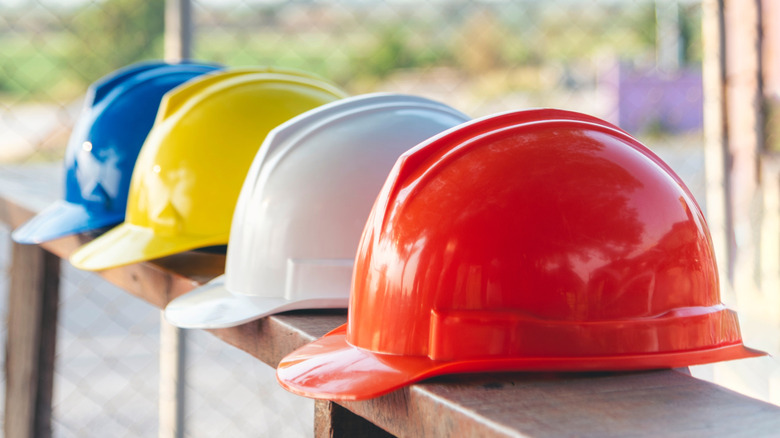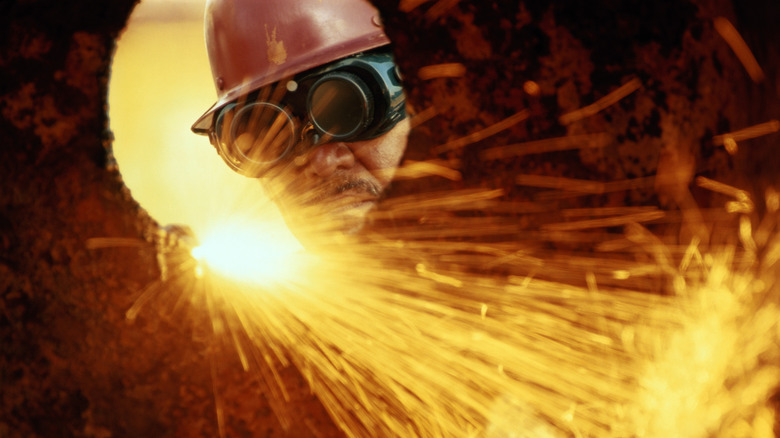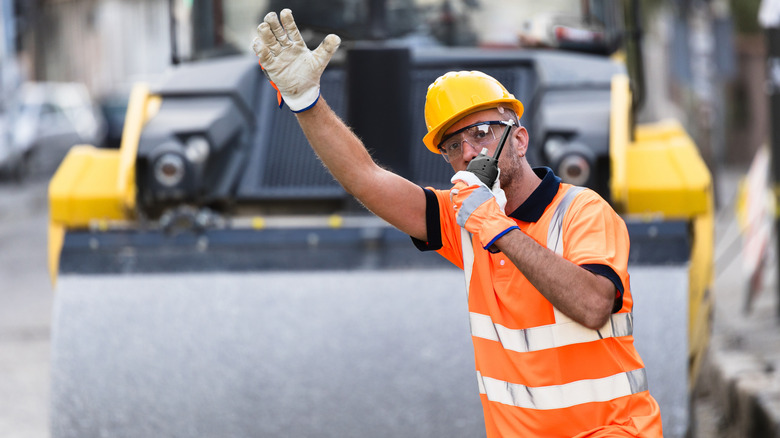Hard Hat Colors Explained: Who Wears What, And Why?
It could be said that most professions have at least one definitive article of clothing — something that makes them readily identifiable by bystanders at a quick glance. One of the most distinctive job-related articles is the hard hat. While a hard hat is a vital piece of safety equipment for both professional workers and home handymen, it has a secondary purpose in the professional field: to immediately tell any passerby, "Hey, there's work going on here, so don't mess around."
While the general shape of a hard hat is fairly consistent, there is one major variable aspect: the color. Hard hats come in a variety of bright colors, and those colors aren't just an aesthetic choice. The color of a hard hat is meant to indicate the job and specialization of whoever is wearing it. This is to the benefit of not only passersby, but other workers on a job site who might need to get a hand from someone with a specific skill set. Once you know what each color of hat indicates, you can immediately infer what a particular worker is doing (or meant to be doing) at a job site.
Yellow hats are worn by general laborers
The most common type of hard hat, and debatably the poster child of the entire hard hat family, is the yellow hard hat. Yellow-hatted workers are general laborers, there to handle the bulk of a construction task. Whether they're lifting large boards, hammering things down, or jackhammering asphalt on the road, you'll see them wearing that distinctive yellow hard hat. General workers both on construction sites and in road work crews will have yellow hats on, and their presence serves as an obvious indicator to pedestrians and motorists that there is some form of labor going on nearby.
Besides regular labor, yellow hard hats are also often worn by construction and earthmoving equipment operators. Large, heavy machinery like bulldozers, excavators, dump trucks, and more will all usually be operated by an individual wearing a yellow hat. Should you see a worker in a yellow hat, it is paramount that you not bother them, as they're likely in the middle of a focused, potentially dangerous task.
Blue hats are for technical workers, green hats are for safety inspectors
Construction work requires various kinds of knowledge and skill sets to finish on time and to code. The general laborers do their work of movement, assembly, and earthmoving well, but more delicate work often requires specialized craftsmen. This is where the blue hat workers come in. Workers wearing blue hats are technical specialists, brought in to accomplish very specific kinds of tasks. This can include workers like carpenters for wood repair and assembly, electricians for electrical installations and maintenance, or general technical advisors for other kinds of advanced sectors and systems.
After the yellow and blue-hatted workers have done their jobs, you may see them replaced by green-hatted workers. This is because workers with green hats are safety inspectors. It's the safety inspector's jobs to go over everything with a fine-toothed comb to ensure it's all up to code and safe. If there's any risk of collapse, injury, or general impropriety, the green-hatted safety inspector will make a report about it. Incidentally, green hats are also occasionally used to indicate a probationary worker, someone new on the scene like a trainee, though a safety inspector is the more common indication.
Brown hats are for high-heat workers, red hats are for firefighters
Certain job sites may require the use of controlled heat in order to build or secure things. The most obvious application of heat would be welding equipment, soldering large components together like fiberglass or carbon fiber. If there are welders on the scene, or any other workers that are utilizing high levels of heat in some capacity, you'll be able to spot them thanks to their distinctive brown-colored hard hats. These hard hats may also have some form of eye protection accessory built into them, not unlike the welding masks and accessories you can buy for yourself.
Of course, not everything on a construction site is meant to be exposed to high heat. Whether through random happenstance or a mistake on a worker's part, a fire could break out where workers would definitely prefer it not be. If there's something on the job site that's on fire when it's not supposed to be, that's a job for the red-hatted workers. Red hard hats indicate firefighters, working to extinguish any sudden blazes. You may also see red-hatted fire marshals working near a job site, keeping paths clear in the event of an emergency.
White hats are for people of authority, grey hats are for visitors
A construction site is meant to be a well-oiled machine of human efficiency, with every worker doing their job. Like any machine, though, someone needs to get the ball rolling and tell everyone where to go. That's the department of the white-hatted workers. If you see a worker on a job site with a white hard hat, that means they're someone in a position of authority. Supervisors, managers, and forepersons will have distinctive white hard hats on so all of the workers know who to come to with any questions or concerns. Other specialists in supervisory roles like engineers and architects may also be wearing white hard hats. Whatever their specific role, that worker is in charge, not to mention responsible for the safety of everyone around them.
An important distinction is the difference between white hard hats and grey hard hats. While a white hard hat indicates a person of authority on a job site, a grey hard hat is pretty much the complete opposite. Grey hard hats are often given to visitors to the site, whether they're associated with the project in some capacity like an investor or just a worker's family member. Besides ensuring a visitor's physical safety, a grey hat indicates to workers that they should be extra-careful around that individual, keeping them out of dangerous areas and away from equipment.
Depending on the job site, there may be other hat colors in use
While the aforementioned hat colors are the most common ones, they're not the only ones out there. Depending on the location and application of the job site in question, plus the policies of whatever company runs it, other, less-common hard hat colors may be in use.
For example, orange hard hats are occasionally used interchangeably with yellow hard hats. You're more likely to see orange hard hats on road crews, repairing asphalt or performing sealcoating, because they're more visible to motorists. If there's a worker directing traffic near a road work site, they may be wearing an orange hat.
Another outlier hard hat color is pink. Pink hard hats are usually loaner hats owned by the construction company. Most workers bring their hats home with them at the end of the day, but if they forget to bring it with them the next day, they'll have to take a pink hat as a loaner.





